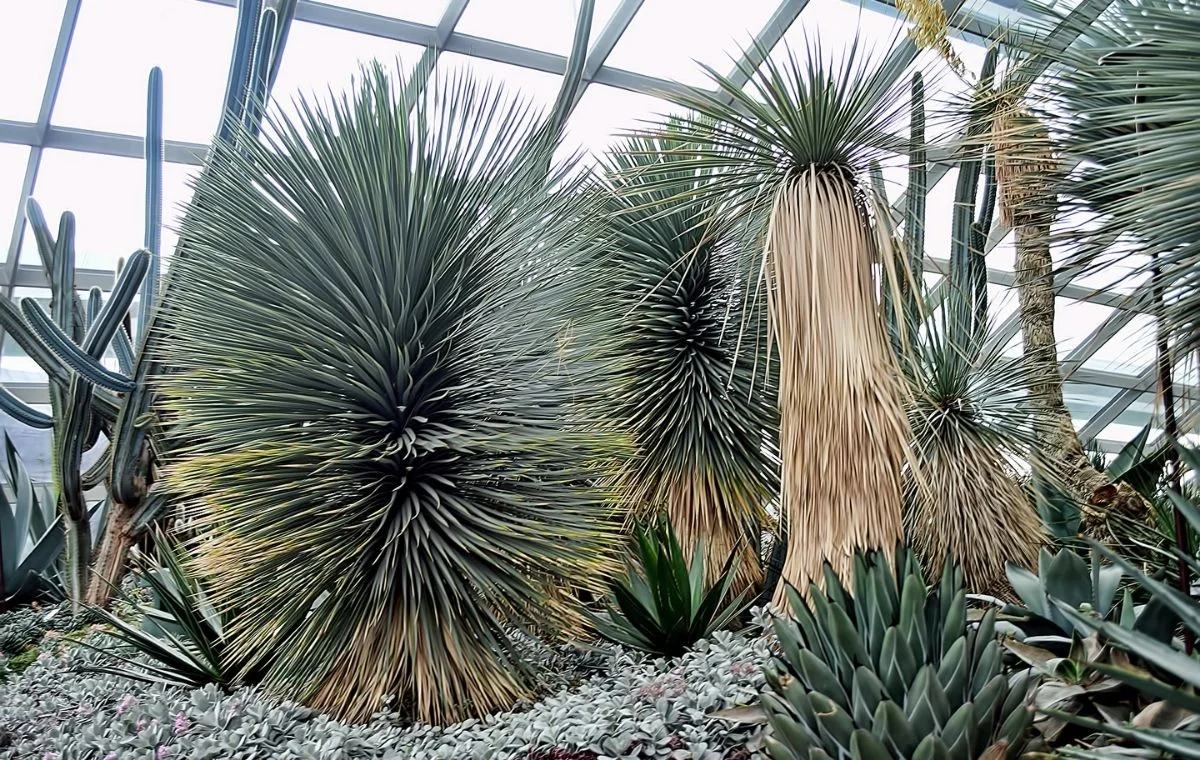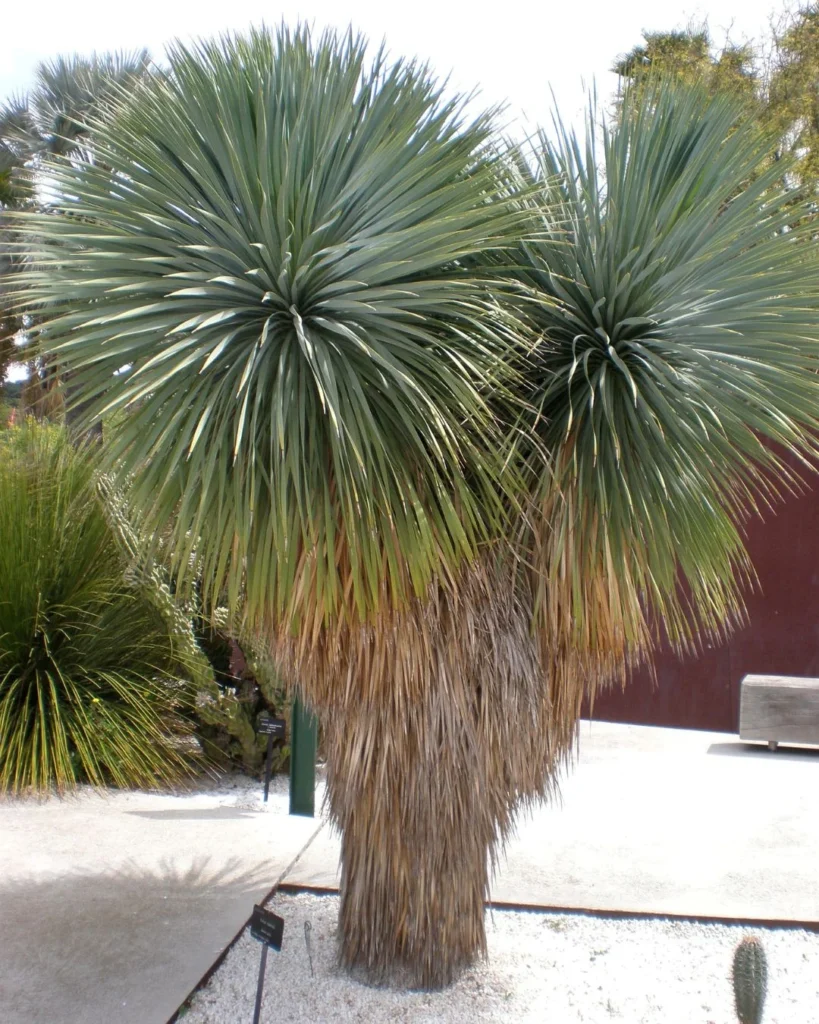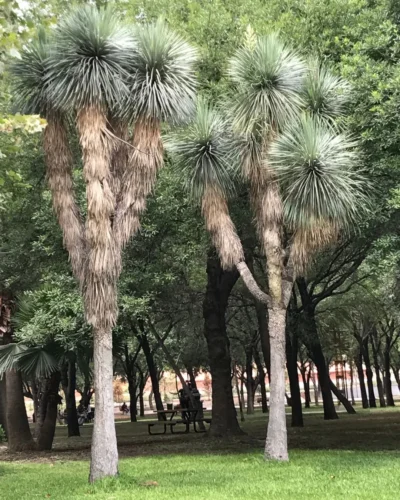
The Beaked Yucca (Yucca rostrata), also known as Blue Yucca, is a shrubby plant native to the southwestern United States and northern Mexico, where it grows in regions ranging from Texas to Chihuahua and Coahuila. This arid and semi-arid habitat is characterized by rocky terrains and well-drained soils, subject to prolonged drought periods. The species has adapted well to these extreme conditions, developing mechanisms to survive in environments with water scarcity.
The genus name Yucca derives from a Caribbean word used to refer to “cassava,” which belongs to the Euphorbiaceae family. This designation was mistakenly attributed to the Yucca genus due to the similarity of its leaves, which resemble the linear leaves of lilies. The genus Yucca was officially classified and published by Carl Linnaeus in 1753. The specific epithet “rostrata” comes from Latin and means “beaked,” a reference to the fruits of the plant.
Yucca rostrata is a slow-growing perennial plant that can reach up to 14.7 feet (4.5 meters) in height. It has a single or rarely branched trunk, with a diameter of 4.7 to 7.9 inches (12 to 20 cm) and a crown forming a dense rosette. Its leaves are linear, long, thin, and pointed, measuring 23.6 to 35.4 inches (60 to 90 cm) in length, but only 0.5 to 1 inch (1.3 to 2.5 cm) wide. They have an interesting glaucous hue, ranging from bluish-gray to light green, with finely serrated edges. As they age, they fold over the stem, forming a curious straw skirt. There is also a cultivar with light blue foliage, called ‘Sapphire Skies’.
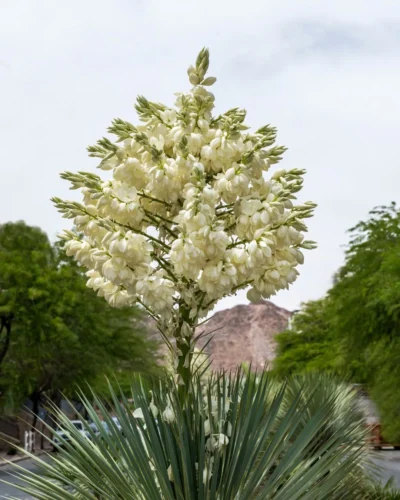
Flowering occurs in spring, summer, or early autumn, producing erect, terminal floral stems in the form of a panicle that easily reach 3.3 feet (1 meter) in height. Its flowers are numerous, quite showy, white to cream-white, and bell-shaped. Flowering usually occurs after periods of rain, with the flowers mainly pollinated by nocturnal moths. Following pollination, the plant produces dry, dehiscent capsule-type fruits, releasing seeds for propagation.
In landscaping, Yucca rostrata is highly valued for its sculptural form and unique texture and color of foliage. Due to its height and shape, it is often used as a focal point in gardens. Its solitary presence or in small groups creates an interesting visual impact, especially in minimalist or contemporary style gardens. Beaked Yucca needs space to shine. When mixed with other species, it tends to lose its prominence.
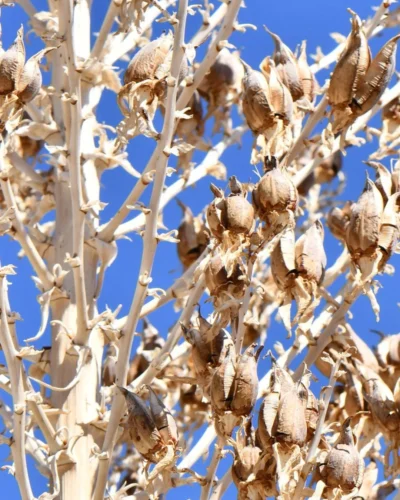
In gardens that mimic arid or rocky environments, Yucca rostrata integrates perfectly. Its use in xeriscaping, which emphasizes water conservation, is particularly relevant given its drought tolerance. Complemented by other drought-resistant plants such as succulents and cacti, it creates a harmonious and sustainable composition. With its imposing structure and unique foliage, Yucca rostrata is an excellent choice for those seeking a low-maintenance plant with a striking effect.
In urban spaces or on terraces, Yucca rostrata can be grown in large pots. In this way, it is especially useful for creating points of interest on balconies, patios, or around swimming pools. The texture and color of the leaves of Yucca rostrata offer a contrast when combined with plants with denser, darker green foliage, as well as against a colorful background wall. This combination can be used to create visual and textural diversity.
Besides its ornamental value, the leaves of Yucca rostrata were used by indigenous peoples to make ropes, fabrics, baskets, sandals, and mats due to their strong and durable fiber. The plant also has medicinal properties, being used in traditional medicine to treat a variety of ailments, such as osteoarthritis, hypertension, migraines, and diabetes.
Cultivating the Yucca rostrata requires attention to several key factors. First and foremost, it is essential to ensure a light, well-drained soil, preferably sandy loam, thus preventing root waterlogging. If necessary, create a raised bed for the plant to facilitate drainage. The plant requires full sun exposure for at least 6 hours a day. It is drought-resistant, and watering should be sparse, increasing frequency only during establishment and active growth periods, if necessary. The Yucca rostrata can withstand low temperatures down to 32°F (0°C), but should be protected from severe frosts or snow. It also suffers in humid winters, requiring protection during this period. Fertilization is rarely necessary, but a balanced fertilizer suitable for cacti and succulents can be applied in spring to encourage growth. Yucca does not require pruning, but can be maintained with two different visual appeals: A more formal one, by removing dry leaves, and a more natural one, keeping the plant’s skirt.
Propagation of Beaked Yucca can be done primarily in three ways: through seeds, offsets (or pups), and cuttings. For seed propagation, they should be collected from dry fruits and planted in well-drained substrate, kept moist, with germination possibly taking several weeks. Offsets that occasionally emerge at the base of the mother plant can be carefully removed and replanted, ensuring they have sufficient roots. Propagation by stem cuttings is less common and more challenging, requiring the cuttings to be dried in the shade to form a callous before planting. Perform cuttings only in spring. Patience is crucial, as the propagation process can be slow.
